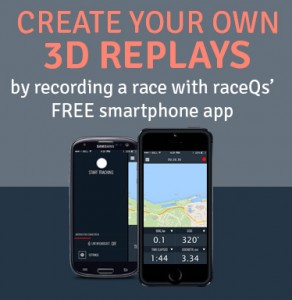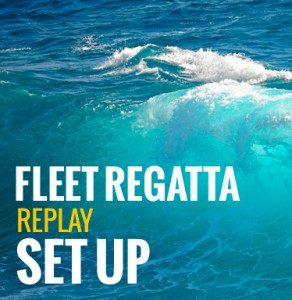Looking for a new strategy to get you clear air at the start of your sailboat race? Watch and learn how to execute the Vanderbilt Start, a full speed approach that gets you out of the pack and over the line while maintaining maximum maneuverability and control.
This short podcast shows how to avoid the crowd of “Reaching In, Reaching Out” starters and get clear air. The Vanderbilt start begins with a broad reach away from the line, instead of a typical beam reach strategy. After making a jibe for the start, you approach attach the starting line with a confident full speed approach. This strategy is easy to adjust if you misjudge the distance to the start, and using full speed gives the helm a lot of control to gain tactical advantage over other boats.
Welcome to “Race to Win”, a sailing podcast brought to you by raceQs.com where we analyze raceQs’ 3d Regatta replays and review racing tactics, rules, and winning strategies.
I’m Julia, and today’s podcast is the second one in a five part series about sailboat race starting strategies. Let’s talk about the Vanderbilt Start, named for famed America’s Cup skipper and super rich guy, Harold Vanderbilt. It’s a simple start, similar in execution to the reach in- reach out start we discussed in the last podcast, with a few key differences.
Before I delve into the finer points of the starting strategy, I want to make sure that we are all on the same page with our 3D animated replay here. This is a replay of the 2013 Melges World championships, in SF bay. The starting are is defined in this replay as a green, shrinking box. On one end, you have the pacer line, which is this line here, that the raceQs’ app actually calculates. On the other end, you have the starting line. Basically, if you are in front of the pacer line you are going to be early to your start, and if you are behind the pacer line, you are going to be late to your start. You want to be just on it to get an on-time start. This is a great visual tool to help us evaluate who did a good job of judging time and distance to the start, and who was a little bit off.
Soon we are going to coming out with a new version of the “perfect start” component of our iPhone app which makes the pacer line show up on the phone screen when you are physically two minutes from the start. It’s a really great tool to help you get to the start on time. Anyways, let’s take a look at how to pull of the Vanderbilt start, otherwise known as the full speed approach. Not unlike the reaching in, reaching out start, this is going to work better in a small friendly fleet, where you can make these long runs out and in without too much interference from other boats and without getting dumped on by bad air.
It’s pretty easy to execute. Start up by the starting line, turn, and reach away for about a minute on a broad reach. The reach-in, reach out crowd will be heading on a beam reach. This means that when you jibe around and head for the start, you will be to lured of a lot of the fleet and have a great view of them to windward.
By taking this slightly different approach, it’s meant to get you out of the pack a little bit. So once you make your jibe around and you are heading back towards the starting line, you want to be going as full speed as possible, not completely full throttle because you want to have a little bit of maneuvering left in case you need to accelerate. What if you were a little bit late to the start? If you are little bit early, you can turn down and sail down the starting line a little bit, keeping your full speed, before you head for the starting line again.
The idea with this approach is that you are able to maintain a lot of control because you are going at almost full speed the entire time. That means you will be able to punch though anyone that is sitting on top of you to w windward, you will be able to roll boats to leeward, luff people up. Speed is one of the things that is going to give you the control that you need to battle your way to a spot on the starting line.
We are going to be using boat 8 as an example. Right now you can see he is kind a stopped, going about a knot. He’s just completed that jibe, we can see that colored line running through the starting line, that’s his GPS track.. He’s already reached away from the starting line had made his jibe and his heading back. There’s one minute to the start, I can see that here with timer I have right here on the right hand side. I also can see who is the closest to the starting line. He’s picking up speed now, again we call this the full speed approach, and you are going to see him maintaining 5-6 knots. He’s slowed a little boat down right now, here’s turning down the line. That’s because he’s a little bit early, we can agree wit that because we can see that he’s a little bit ahead of the pacer line. You can see how is to lured of this whole group of people over there who were probably doing more of a reach in reach out approach, as opposed to the Vanderbilt start where remember, you go away on a broad reach, so you end up below everybody.
He is sailing a zigzag course which is a great way to slow down if you are a little bit early, but he is going to maintain his full speed and start at about 6 knots. And off he goes. Of the 25 boats that we recorded, he is 6th across the starting line, which is really pretty good.
Now I say this isn’t for crowded fleets, but you know there was about 60 boats in this regatta although we only recorded about 25 he re in the replay. But these are professional level racers, so he was able to make this work and get a pretty good start.
Of course, like we always say, there is no “magic bullet” for getting the perfect start, every time. A savvy skipper is going to listen to these podcasts, have everything filed away, and then adapt the techniques on the fly when necessary. Now that you know that basics of the Vanderbilt start, and reaching in and out, you’ve got a couple of things to try out if you’re getting back in to spring sailing. And you might want to try out the free raceQs app and make your own 3D replay. It’s amazing to go back and swath yourself, and see what you could of done differently. The raceQs’ app is totally free, it so give I t a try! You can download it for iPhones, or most Andriods. If you try out the app send us a clip! We’d love to interview you ,and maybe even feature you in our next podcast. See you next time.
If you enjoy this podcast, you can find more on our website. ww.raceqs.com/podcast. Or, search or raceqs.com on itunes and click subscribe. We would love to hear from you so please give us a reivew, on itunes.











